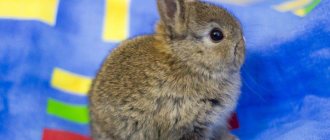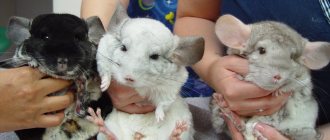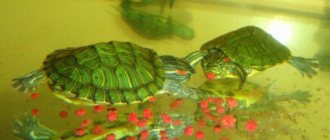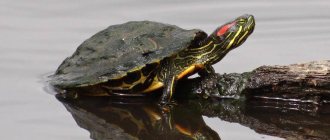Description of the species
Red-eared turtles in nature reach 30 cm in length (based on the shell), but when kept at home they rarely grow to that size. Females are significantly larger than males. The shell of juveniles is bright green, but as the turtle matures it becomes brown or olive in color with patterns of bright yellow stripes.
The head, neck and paws of the animal are decorated with a series of white and black stripes. The species got its name due to the bright red spots near the eyes. These “ears” can also be deep orange or rich yellow. It is thanks to its bright appearance that the red-eared turtle has become one of the most popular exotic pets.
She prefers to lead a sedentary lifestyle, but swims very quickly in the water and is extremely curious. May hiss and snort, expressing his displeasure and anxiety. When defending its life, it can inflict serious wounds with the sharp claws of its hind legs. In the cold season, a phenomenon called suspended animation, or hibernation, occurs for red-eared turtles.
Requirements for aquatic reptiles
Often, pet stores sell coin-sized babies and convince the buyer that a 30-liter aquarium will be the ideal solution. This is mistake. Even for a small reptile, the aquarium must be spacious, but for an adult, it must be taken into account that a minimum of 200-300 liters of water will be required.
Effective filtration is required, preferably in the form of an external filter, appropriate lighting, including UV, and a proper diet. Aquaterrariums use soil and gravel.
How long does the red ear live and where does it live?
This type of turtle can rightfully be considered a long-liver. In favorable conditions, life expectancy is 40 years. An interesting fact is that the red-eared turtle has a high level of intelligence, not typical of other reptiles. These animals are very sensitive to vibrations and their behavior can warn of an impending earthquake or storm. When choosing food, the red-eared turtle first focuses on the color, and only then on the smell and taste of the object.
These reptiles are widespread in nature. They can be found in their natural environment in Central and South America, Israel, South Africa, Spain and even Great Britain. But in Australia, this species is officially recognized as a pest, since it destroys local endemics. The red ear lives in shallow ponds and lakes, and in other bodies of water with swampy shores.
Compatibility
Turtles are loners. In their natural environment, they gather in groups for mating and fighting. Keep turtles together only if there is no other option and they are of the same species and size. But even then conflicts arise. Different breeds require different conditions of maintenance.
Keep exotic turtles separately.
They can coexist with some iguanas in large vertical terrariums. If you try to make friends with a small reptile, the latter may lose its tail or paws. Turtle secretions are poisonous to snakes.
Keeping at home
Keeping this exotic animal turns out to be much more difficult than initially thought. These turtles spend most of their time in the water, although they need land. For one adult, an aquaterrarium with a volume of 120-150 liters will be comfortable, while land should occupy no more than 25% of the total area. On the improvised bank, special soil or crushed stone should be poured, making a gentle rise. The turtle's shell must fit completely in the water so that the animal can easily roll over onto its back and back.
For this type of amphibian, the optimal temperature is 25-30 degrees Celsius. When the temperature drops to 20 degrees, hibernation may occur in red-eared turtles. The water in the aquarium is changed as needed, at least once a month. In order for the turtle to be healthy, it also needs to be provided with portioned irradiation with an ultraviolet lamp.
Reviews from aquarists
Reviews from owners are varied. Someone expresses complete delight, another begins to hate the animal.
What to feed the red ear?
When living in captivity, the diet of this species of turtle must include shrimp or any other small crustaceans. The red-eared turtle will happily feast on river snails, small pieces of fresh fish or meat, as well as bloodworms and earthworms. Turtles need to get enough calcium, otherwise shell diseases will begin. Poor appetite may indicate illness. Hibernation of red-eared turtles is also preceded by a decrease in interest in food.
It is worth adding plant foods: duckweed, seaweed, lettuce, spinach, cabbage. Due to the active growth of the body, young individuals need twice daily feeding. Turtles over two years old should be fed no more than three times a week. With a monotonous diet, it is worthwhile to provide feeding with special vitamins for turtles.
Dreamer's personality
The dreamer’s personality also plays a role in the interpretation of a dream about a turtle:
- Unmarried young ladies will soon meet a man. Serious passions will flare up between young people, and mutual sympathy will develop into real feelings that will last a long time. But you shouldn’t count on marriage and starting a family with this man.
- Entrepreneurs can expect fruitful cooperation and business connections. The sleeper will be able to find a reliable business partner and reach a new level.
- Single men should beware: they will get involved in unpleasant things, and this will happen by accident. You should beware of dubious enterprises.
- Young people will be promoted and receive a small profit.
- For lovers, a turtle is a symbol of a strong love connection. Relationships can develop into something more.
- The turtle warns pregnant women that childbirth will be painful and long, and recovery will take several months.
- A married woman will soon learn about her pregnancy, and this news will greatly delight her husband.
- For sick people, a turtle is a sign that the disease will not go away soon.
- Children will have a pleasant time with their parents, for example, going to the zoo together.
Hibernation of red-eared turtles
As mentioned above, this type of amphibian can fall into suspended animation - a state of reduced activity. Usually this period occurs during the cold season and is a protective reaction of the animal’s body to a decrease in temperature and a decrease in the amount of available food.
How does a red-eared turtle sleep at home? Considering the optimal conditions for keeping the amphibian and the lack of the need to get its own food, domestic red eared cats may not go into suspended animation at all. But since instincts can work at the subconscious level, in winter the turtle may be more lethargic and suffer from poor appetite.
If you notice this behavior in your pet, it is best to take him to the vet, as it may be caused by an illness. How long does a red-eared slider sleep? Typically, the period of suspended animation lasts one to three months, but at home it can be much shorter.
Is hibernation artificially induced in red-eared turtles? Yes, you can deliberately put an animal into a state of suspended animation. To do this, simply lower the temperature and reduce the lighting in the aquarium. However, it is best to consult with your veterinarian about the need for artificial hibernation before taking any action.
Setting up an aquaterrarium
For one ward you will need a 100-liter aquarium; a couple of different sexes will need a capacity of 150 liters or more. Next, we create the interior of the turtle’s home, taking into account the fact that land should occupy approximately 25% of the area of water. At the same time, let’s not forget our interests – the beauty of the aquaterrarium. If you wish, you can purchase an artificial shore at a pet store, but then you won’t get a real corner of wildlife. But you want not only to keep the red-eared turtle, but also to enjoy the whole composition.
We will be guided by the last condition:
- Place a large stone with a flat surface at the end of the aquarium. When calculating its size, take into account the distance from the top edge of the future aquaterrarium - it should not exceed 40 centimeters.
- If the land slope is not gentle enough, you need to make a bridge to it from the water. Frequent, stable steps made of smaller stones or suitable driftwood without jagged edges will do.
- Next, we fill the soil not only at the bottom. Be sure to fill the space between the walls with stone and under the bridge. If this is not done, even though it is aquatic, the reptile may get stuck there and drown. The size of the soil also matters - red-eared turtles can swallow small pebbles and die.
- Living bottom plants will be quickly eaten. Therefore, it is better to choose emergent species with a root system located in ceramic pots or other reliable decorations at the bottom. For example, dwarf papyrus, water hyacinth and similar vegetation.
We will return to the small but important details of the interior later. Now it’s time to pour water into the almost finished aquaterrarium. Let's start with its parameters - temperature 22-28ºС, soft like peat, with neutral acidity
It is important to take into account the water level - it should be such that a turtle turned over on its back can find support on the bottom or decorations and independently return to its original position. Now regarding the required equipment:
- A good external filter for the red-eared turtle is very important because it feeds and defecates directly in the water.
- To heat the shore, you need a regular 40W lamp located directly above it. Stronger light bulbs can only be installed at a distance from land above fifty centimeters - otherwise burns cannot be avoided. The optimal temperature of a dry surface should not exceed 35ºС.
- Ultraviolet lamp for reptiles. It makes more sense to purchase it in a specialized store. It is better not to experiment with UV lamps intended for humans - the wavelength is completely different and the reptile’s body will not produce the vitamins necessary for the absorption of calcium.
- Thermostat to maintain a constant water temperature. When purchasing it, make sure that you need a model that is suitable for the aquaterrarium.
After the housing for the aquarium red-eared turtle is ready, it is recommended to let it stand without a pet for at least a couple of days. By the way, it needs to be positioned so that it is not exposed to direct sunlight. While the water is settling, there is time to go to pet stores in search of a “new home.”
How and how long do red-eared turtles sleep?
Before you get yourself a pet - a red-eared turtle - you need to find out about the acceptable conditions for keeping it. Perhaps the very first thing people who have a pet want to know is how do red-eared turtles sleep and do they hibernate?
Turtle hibernation
Under natural conditions, animals simply need to hibernate due to a sharp drop in ambient temperature. If you observe the behavior of a turtle in nature, you can understand how much red-eared turtles sleep in winter. Under natural conditions, the period of sleep can reach five months, while the animal practically does not breathe. All body processes slow down, and fat accumulated during the waking period is spent on their implementation. At home, it is not recommended to create conditions for turtle hibernation. This is a very labor-intensive process - you need to deprive your pet of food for a week, then place it in damp moss and gradually reduce the temperature of the environment around it. As a rule, to the question - how long do turtles sleep at home in winter - there is only one answer: no more than three months.
Adviсe
- The turtle will not play like a cat or dog.
- Protect your pet from drafts, feed it a variety of food, and treat it on time.
- Think carefully about the purchase, because the pet lives quite a long time, and if released into the wild, it will die in the natural conditions of central Russia.
Turtle is a great choice for people who don't like noise. A leisurely turtle relaxes and clears the mind of hustle and bustle, and taking care of it brings true pleasure.
Previous InhabitantsWhat to feed omnivorous and herbivorous land turtles at home? Next InhabitantsTricks for keeping a Chinese newt
How do red-eared turtles sleep?
How do turtles sleep at home and do they sleep at all? Of course, every pet simply needs physical rest. Many people want to know whether turtles sleep at night, complaining that the pet is unusually active at night.
Every turtle sleeps, only in some individuals the duration of sleep and its frequency may differ. It is quite possible that the pet does not sleep at night, but during the day, when no one is in the apartment, it sleeps. There are also turtles that sleep all night and try to rest several times during the day. Sleep can find your pet everywhere - both in water and on land. According to observations, most domestic red-eared turtles prefer to rest on land.
What determines the red-eared turtle's sleep?
First of all, a turtle's sleep depends on its activity. If you want to know how much turtles sleep, which do not show much activity during the day, the answer will upset you a little. Due to the fact that the turtle is inactive, less energy is spent, therefore, the pet needs less time to sleep. And vice versa, if your pet moves very quickly and is constantly busy with something, his sleep will be sound and long.
Also, the length of rest may depend on the sex of the turtle. Almost no one knows how to distinguish the sex of a turtle at a young age. In most cases this is impossible to do. Sex is determined in adulthood by the length of the tail (it is longer in males) and claws (in boys, the front claws are longer than the back ones). Also, sleep may depend on the occurrence of any disease. Some diseases of red-eared turtles can affect the disruption of the life cycle; the animal will either sleep too long, or vice versa – not fall asleep at all.
In principle, it is impossible to predict how much turtles sleep in different conditions. The duration of sleep is a purely individual factor, which depends primarily on the turtle itself, on its surrounding conditions and the rest it requires.
Taming
To help your turtle eat from your hands, feed it while holding the food with your fingertips. Remember, once your pet gets used to this way of eating, it will begin to chase its owner.
Initially, turtles are not very friendly towards people. To wean your animal from biting, pick it up more often without making sudden movements.
Turtles have excellent hearing; when giving food or before bathing, make the same sound and the pet will begin to respond to it.
Animals remember and recognize their owner. They love to watch what is happening in the room.
Habits are quickly formed regarding feeding times and daylight hours. Not receiving food at the usual time, the pet will sigh and move its head in disappointment.
How do turtles sleep?
Aquatic turtles (red-eared, marsh) can sleep both on land and under water. Sleep can also catch them during a walk, when the owner releases the animal from the aquarium. Therefore, you need to do this only for a few hours and periodically monitor your pet so that it does not get lost or get stuck in hard-to-reach places.
Most often, domestic red-eared turtles sleep on land. They climb onto the island, close their eyes, calm down and fall asleep. Some animals retract their head and paws into their shell, while others do not. They leave their head extended and simply close their eyes. This happens because they get used to a calm environment, the absence of predators and competitors.
However, the red-eared turtle can also sleep in water. A sufficient amount of air accumulates in her lungs, the supply of which lasts for several hours. The animal sleeps in the water, completely submerged there, or stands on its hind legs on the bottom of the aquarium, and rests its front legs on an island or other object. The pet can spend several hours in a row in this position.
Anaerobic respiration process
After inhaling, the turtle slowly sinks, the processes of oxygen absorption from the lungs into the blood continue for the next 10-20 minutes. Carbon dioxide accumulates without causing irritation or requiring immediate exhalation, as in mammals. At the same time, anaerobic respiration is activated, which at the final stage of absorption replaces gas exchange through the lung tissue.
During anaerobic respiration, tissues located at the back of the pharynx, in the cloaca, are used - the layering makes these pads look like gills. It only takes a few seconds for the animal to remove carbon dioxide and then take in air again when ascending. Most species exhale sharply into the water before raising their head above the surface and drawing in air through their nostrils.
When and how long do they sleep?
The answer to this question is ambiguous, since each animal develops its own habits over time. The duration of sleep and the characteristics of biorhythms depend on a number of factors:
- Gender
: Males have been found to sleep longer than females. Males can be distinguished by their more powerful paws and long tail. - Age
: young individuals are very active, they can swim around the aquarium all day, play, run around the room if the owners let them out. As a result, such turtles fall asleep for several hours, just like a person. They get very tired and can sleep all night. An old turtle often falls asleep on the go, it is slow and behaves calmly, so it requires less time to sleep. - Health status
: if the pet is cheerful and behaves as usual, nothing threatens its health. But sometimes the animal can become slow, falling into a kind of hibernation for 5-7 days in a row or more. Inexperienced owners may even think that the reptile has died, although in fact it is simply resting to recuperate. - Individual characteristics
: it is not the duration of sleep that depends on them, but biorhythms, i.e. time of falling asleep and waking up. There is no general law here: some turtles like to sleep during the day, after which they make noise all night. Others, on the contrary, fall asleep at night because during the day they are disturbed by light, noise from people, household appliances, etc.
Price
The cost of an individual varies from 200 rubles to 150,000 or more for rare species. The refusenik can be found on websites for free.
| Name | Price (rubles) |
| Greek, Mediterranean (Testudo graeca) | 2160–4800 |
| Leopard, Panther (Stigmochelys pardalis) | 3840–7680 |
| Indian starfish (Geochelone elegans) | 5000–12000 |
| Redfoot, Charcoal (Chelonoidis carbonaria) | 3840–4800 |
| Madagascar radiata (Astrochelys radiata) | 24000 |
| Central Asian (Agrionemys horsfieldii) | 500–3000 |
Prices depend on characteristics:
- floor;
- age;
- rarity of the species.
If your turtle sleeps too long or too little
In this case, you just need to observe the behavior of the animal. If the pet eats well, swims actively, communicates with other neighbors in the aquarium, i.e. behaves as usual, her health is safe. Typically, such periods of instability end after a few weeks, after which red-eared turtles spend the night in their usual rhythm.
If your reptile sleeps very little and is too active, it should be taken to the veterinarian. He will be able to clarify the reason for this behavior and prescribe sedatives and other medications. If turtles sleep a lot, literally for several days in a row, but wake up, feed, swim and fall asleep again, this is quite normal. If a sleeping turtle is not active at all, this may indicate the beginning of the development of the disease.
The only exceptions are those cases when the animal has gone into hibernation. This usually happens during the autumn-winter season, provided that the owner specially prepares the pet. To do this, reduce the temperature in the aquarium for several days in a row, significantly reduce portions or do not feed the turtle at all, etc.
Motives for long sleep
A considerable number of lovers often wonder why the turtle sleeps all the time? What are the reasons for such a long dream? The reasons for long sleep are:
A change of scenery. The cause of stress is not only moving to a new home, but also moving the terrarium to another room. During the adaptation period, which lasts a couple of weeks, the pet will get used to it and become active again.
In winter, install additional lighting.
Reducing daylight hours. With the onset of autumn, the days become shorter, the reptile reacts to the reduction in natural light.
The situation can be changed by installing additional lighting that will maintain the required day length. Temperature in the terrarium. Elevated temperatures provoke forced cooling of the body, forcing the animal to climb into the ground or water. Reduced - automatically prepares the turtle for hibernation. By setting a constant, optimal temperature for the turtle from +26 to +33°, the pet’s condition is leveled out.
It is worth noting that the reptile sleeps quite often and for a long time, especially after a hearty lunch. But if this worries the owner, consultation with a herpetologist is necessary.
Why does a turtle have a soft shell?
Unusual Ways of Breathing
In addition to ordinary breathing through the nostrils, most representatives of freshwater species are able to obtain oxygen in another way. You can hear that aquatic turtles breathe with their butts - such a unique method really exists, and these animals are called “bimodal breathers.” Special cells located both in the animal’s throat and in the cloaca are capable of absorbing oxygen directly from the water. The drawing in and expulsion of water from the cloaca creates a process that can truly be called “butt breathing” - some species perform several dozen such movements per minute. This allows reptiles to make deep dives without rising to the surface for up to 10-12 hours.
The most striking representative using a double respiratory system is the FitzRoy turtle, which lives in the Australian river of the same name. This turtle literally breathes underwater, thanks to special tissues in the cloaca bags filled with many vessels. This gives her the opportunity not to float to the surface for up to several days. The disadvantage of this method of breathing is the high requirements for the purity of water - the animal will not be able to obtain oxygen from a cloudy liquid contaminated with various impurities.
Respiratory system device
In mammals, including humans, when breathing, the diaphragm increases and air is drawn into the lungs - movable ribs allow this to be done. In turtles, all internal organs are surrounded by a shell, and the chest area is motionless, so the process of air intake is completely different. The respiratory system of these animals consists of the following organs:
- external nostrils - inhalation is carried out through them;
- internal nostrils (called choanae) - located in the sky and adjacent to the laryngeal slit;
- dilator - a muscle that opens the larynx during inhalation and exhalation;
- short trachea - consists of cartilaginous rings, conducts air to the bronchi;
- bronchi - branch in two, conducting oxygen to the lungs;
- pulmonary tissue - located on the sides, occupying the upper part of the body.
The turtle's breathing is carried out thanks to two groups of muscles located in the abdomen. Reptiles do not have a diaphragm separating the internal organs from the lungs; when inhaling, the muscles simply move the organs aside, allowing spongy lung tissue to fill the entire space. When you exhale, a reverse movement occurs and the pressure of the internal organs forces the lungs to contract and expel waste air.
Often the paws and head are also actively involved in the process - by retracting them, the animal reduces the internal free space and pushes air out of the lungs. The absence of a diaphragm prevents the formation of back pressure in the chest, so lung damage does not stop the breathing process. Thanks to this, turtles can survive when their shell breaks.
Big, small animal
Good news, good omens - the main interpretations of what turtles, big and small, dream about.
Large reptiles mean:
- according to Tsvetkov, they guarantee successful earning options if the sleeping young lady wisely uses the information received in reality, thanks to which she herself will become rich and help the family;
- for a woman who dreams of becoming pregnant, a large reptile promises an early pregnancy;
- a beautiful turtle of enormous size promises quick enrichment;
- a giant animal of unrealistic size (larger than a house, for example) is an unfavorable sign and threatens stagnation in business or service. The closer the animal is to the sleeping one, the easier it will be to find the key to the problem.
Let's look at why little turtles dream:
- those running around the body threaten a string of minor problems, but they will be easy to deal with;
- the turtles got into the pockets of their clothes - a new business, a position will turn out to be a failure, they may deceive, not pay the money they earned.
Medium-sized animals are fraught with worries about the health of a close relative or loved one. The outcome of the disease depends on the outcome of sleep.
Improper feeding
Perhaps the red-eared turtle does not eat because it is given the wrong food. She needs animal and plant food. Reptiles should be given lean meat: beef, poultry, horse meat is also suitable. But pork and lamb are contraindicated for turtles, since they are too fatty and the animal’s gastrointestinal tract is not designed to digest them.
In addition to meat, your pet can be given offal. To prevent calcium deficiency in the reptile's body, the diet should include shrimp and low-fat sea fish, which should be given along with bones. You can give raw snails and squid.
But in the absence of plant food, the animal will develop hypovitaminosis and other health problems. You can give dandelion and plantain leaves, carrots, beets, pumpkin, cucumbers, and zucchini.
The older the pet is, the more plant foods should be included in its diet.
But small turtles may refuse if they are given vegetables and fruits; they prefer animal food.
You should not give your pet boiled or fried foods, bread, or dairy products (except cottage cheese).
It is also important to follow the reptile's feeding schedule. She may be fed too often and given too much food.
While the turtle is small, its age is less than 12 months or its size is less than 10 cm, it is fed daily. Adults are given food 2-3 times a week. To determine the volume of one serving, you need to see how much the reptile eats in 30 minutes and give this amount constantly
She may be fed too often and given too much food. While the turtle is small, its age is less than 12 months or its size is less than 10 cm, it is fed daily. Adults are given food 2-3 times a week. To determine the volume of one serving, you need to see how much the reptile eats in 30 minutes and give this amount constantly.
Proper nutrition is the key to longevity
If the turtle died, but the aquarium, temperature conditions and other rules were observed, then perhaps the owner used the wrong diet, which killed the pet. One of the causes of death may be the use of only special reptile food. Such food should not be used as the main diet. It is recommended to use any dry food for fish or turtles as a treat for your pet and give it in dosed form no more than once a week.
An equally common cause of death is frequent consumption of moths. They can cause your pet to become infected with many diseases. If the moth is stored incorrectly or bred in the wrong conditions, then it is not only harmful, but also brings fatal diseases. It is better to completely exclude such a product from the diet if you are not sure about it.
It is recommended to feed your pet raw fish. In this case, you can use both sea and freshwater, preferably low-fat varieties. It is prohibited to feed trout, salmon, capelin and other types of fatty fish. Also, the basis of a proper diet includes poultry and beef by-products; you can give seafood, such as squid or shrimp. When giving your pets fish, you do not need to clean it or remove bones. They contain many useful vitamins and elements.
By using a healthy diet, you can achieve positive results for your turtle's health. It is imperative to remember that it is strictly forbidden to feed lard, skin or meat with greasy streaks. Reptiles are designed in such a way that they will not be able to digest such a product, nor do they have the ability to regurgitate it. As a result, they may become ill, digestion may be impaired, and even death may occur.
From plant foods, you can feed your pet lettuce, carrots, cabbage and dandelions. It is also possible that they may be fed duckweed or various types of algae. During the summer, you can feed some beetles, worms or insects. Such products can be easily stored in a refrigerator in a glass container. For long-term preservation, you should put tea leaves inside. In this case, every day the worms will need to be washed under running cold water and can be used to feed them constantly.
Alternatively, the worms can be frozen. Before serving them to your pet, you will need to rinse them under highly salted water or wash them in a light solution of manganese. Pets get significant amounts of calcium, carbohydrates and proteins from insects and worms. It can also improve and strengthen your pet’s overall health.
For proper and balanced nutrition, it is recommended to make your own food based on gelatin. To do this, you will need to mince carrots (70 g), cabbage and apple (50 g each), any permitted fish (140 g), squid fillet (100 g), and egg (2 pcs.). Then add milk and water (150 g each) to the resulting slurry. You first need to dissolve gelatin (30 g) in them and add Tetravit (20 drops). After this, add a couple of eggs and mix. Then the food is sent to a refrigerator to harden. Before serving, the food should be cut into pieces and allowed to warm up a little. This food is enough for 10 meals for an adult.
As for the feeding schedule, pets under 2 years of age should be given food every day, and the dose should be such that the turtle can eat in a maximum of 30 minutes. For reptiles over 2 years old, food is given 3 times a week, in the same amount. The main thing is to avoid overeating so that your pet does not become obese.
It is better to feed your pet from a separate container so that the water does not become clogged. All products that enter the water turn into a variety of bacteria, fungi and can cause infectious diseases and even death.
Using all the rules described, you can exclude causes of death. And since the pet is not land-dwelling, you should definitely monitor the purity of the water.











